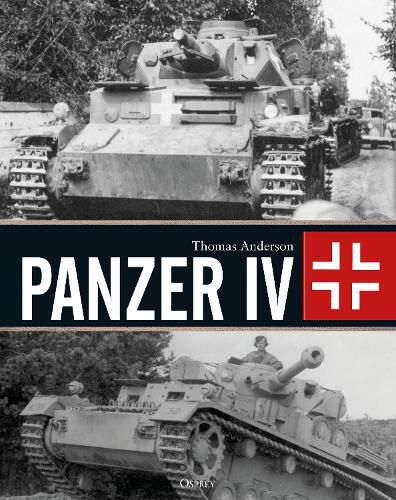Readings Newsletter
Become a Readings Member to make your shopping experience even easier.
Sign in or sign up for free!
You’re not far away from qualifying for FREE standard shipping within Australia
You’ve qualified for FREE standard shipping within Australia
The cart is loading…






The Panzer IV programme was started in the very early days of German tank development in 1934. Due to the restrictions of the Treaty of Versailles the new type was ‘disguised’ as an escort vehicle) but this subterfuge was dropped in 1935 and the type became known as the Panzerkampfwagen (PzKpfw) IV. This new tank along with the PzKpfw II and PzKpfw III was used to equip the schnellen Truppen, the force that was to become the Panzerwaffe.
At first, German armoured warfare planners decided to deploy the PzKpfw IV in a secondary role providin short- and medium-range fire support for PzKpfw III-equipped forces. But, following the conclusion of the Polish campaign, Hitler turned his attention to capturing The Low Countries, Belgium and France, and his forces would require a more powerfully armed tank to defeat the heavily armed French tanks. The PzKpfw IV armed with the 7.5cm KwK 37 L/24 gun entered the line of battle.
The strategic and tactical success of Unternehmen (Operation) Barbarossa allowed the Panzerwaffe to make a rapid advance to Moscow. Here in the autumn of 1941, the force was halted by more modern (and better armed) Soviet-built T-34 medium and KV-1 heavy tanks. Both types were able defeat German armour, including the PzKpfw IV. However, the PzKpfw IV could easily be improved. After being mounted with the more powerful long-barrelled 7.5cm KwK L/43 and improved armour protection, the medium tank became the main battle tank in Panzerwaffe service. The PzKpfw IV gradually replaced the PzKpfw III, as this tank could not be upgraded in the same way. When armed with the even more powerful 7.5cm KwK L/48, the Panzer IV could fight and defeat the modern Soviet tanks, and those of Allied forces encountered in North Africa and Italy. Although in 1943 growing numbers of the advanced PzKpfw V Panther medium tank were being delivered, there were never enough to replace the PzKpfw IV. The dire German situation made it necessary for the PzKpfw IV to be kept in production and it remained in service during the fierce defensive tank battles on Eastern Front; here the Panzerwaffe stood firm against the massed Soviet offensives of 1943 and 1944. At the time of the D-Day landings, there were also more PzKpfw IV in service with the Panzerwaffe in France than PzKpfw V Panther tanks. During 1944 the PzKpfw IV was being gradually replaced by Sturmgeschutz, Jagdpanzer and PzKpfw V Panthers, but the type was to remain in front-line service until the end of the war.
$9.00 standard shipping within Australia
FREE standard shipping within Australia for orders over $100.00
Express & International shipping calculated at checkout
The Panzer IV programme was started in the very early days of German tank development in 1934. Due to the restrictions of the Treaty of Versailles the new type was ‘disguised’ as an escort vehicle) but this subterfuge was dropped in 1935 and the type became known as the Panzerkampfwagen (PzKpfw) IV. This new tank along with the PzKpfw II and PzKpfw III was used to equip the schnellen Truppen, the force that was to become the Panzerwaffe.
At first, German armoured warfare planners decided to deploy the PzKpfw IV in a secondary role providin short- and medium-range fire support for PzKpfw III-equipped forces. But, following the conclusion of the Polish campaign, Hitler turned his attention to capturing The Low Countries, Belgium and France, and his forces would require a more powerfully armed tank to defeat the heavily armed French tanks. The PzKpfw IV armed with the 7.5cm KwK 37 L/24 gun entered the line of battle.
The strategic and tactical success of Unternehmen (Operation) Barbarossa allowed the Panzerwaffe to make a rapid advance to Moscow. Here in the autumn of 1941, the force was halted by more modern (and better armed) Soviet-built T-34 medium and KV-1 heavy tanks. Both types were able defeat German armour, including the PzKpfw IV. However, the PzKpfw IV could easily be improved. After being mounted with the more powerful long-barrelled 7.5cm KwK L/43 and improved armour protection, the medium tank became the main battle tank in Panzerwaffe service. The PzKpfw IV gradually replaced the PzKpfw III, as this tank could not be upgraded in the same way. When armed with the even more powerful 7.5cm KwK L/48, the Panzer IV could fight and defeat the modern Soviet tanks, and those of Allied forces encountered in North Africa and Italy. Although in 1943 growing numbers of the advanced PzKpfw V Panther medium tank were being delivered, there were never enough to replace the PzKpfw IV. The dire German situation made it necessary for the PzKpfw IV to be kept in production and it remained in service during the fierce defensive tank battles on Eastern Front; here the Panzerwaffe stood firm against the massed Soviet offensives of 1943 and 1944. At the time of the D-Day landings, there were also more PzKpfw IV in service with the Panzerwaffe in France than PzKpfw V Panther tanks. During 1944 the PzKpfw IV was being gradually replaced by Sturmgeschutz, Jagdpanzer and PzKpfw V Panthers, but the type was to remain in front-line service until the end of the war.